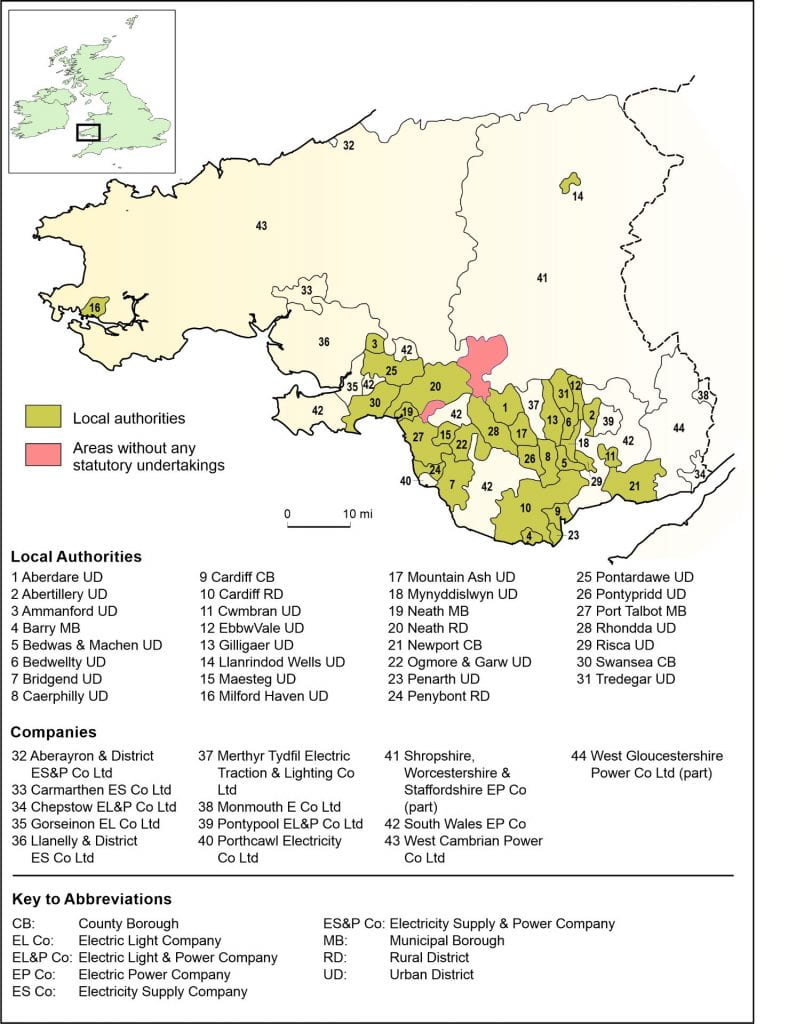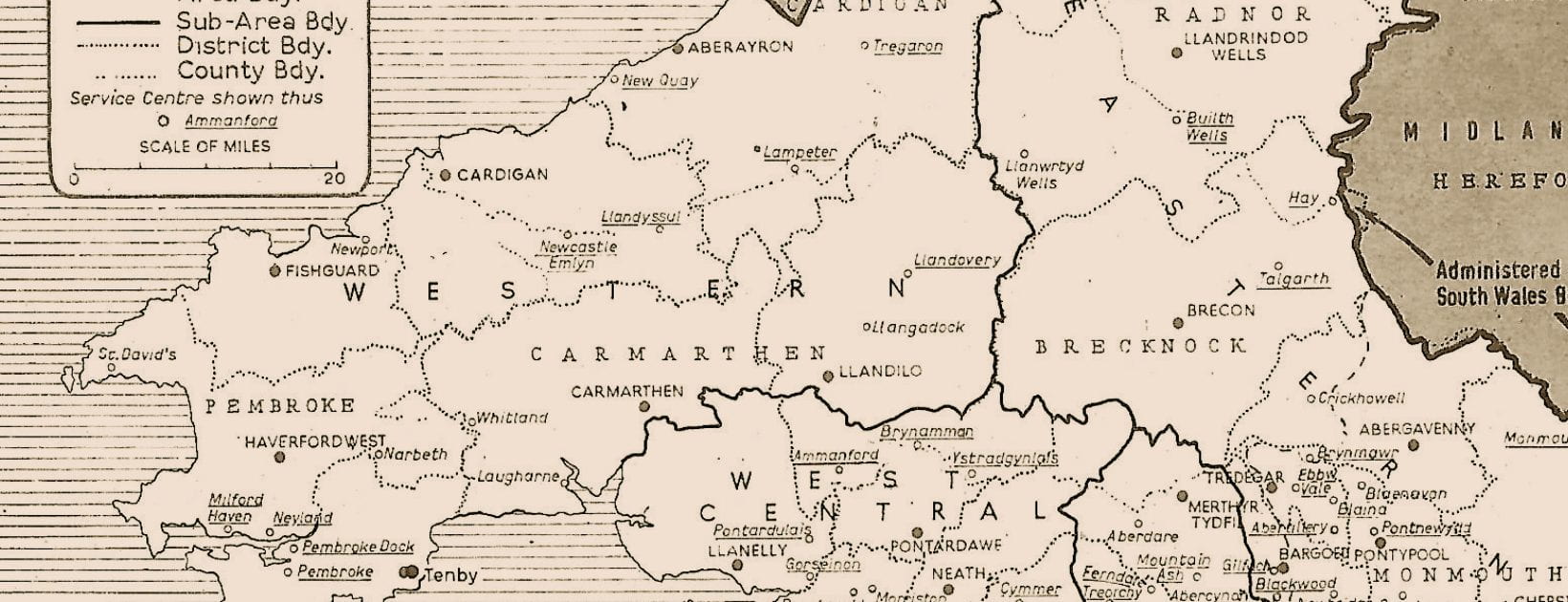South Wales Development of Electricity Supply Areas
The 1948 pattern illustrated in Figure 1 represented the climax of over 50 years of development. Unusually for a new innovation, electricity for public supply was subject to tight national regulations from an early stage. The Electric Lighting Act 1882 required “undertakings” to apply for a licence or provisional order from the Board of Trade.[4] This requirement followed the precedents for earlier public utilities which had to “break up the streets” to lay mains or tracks. Electric Lighting Orders provided the basic conditions of a franchise to operate within a defined area, limiting the maximum prices that could be charged to consumers and, for private companies, a time limit of 21 years after which the local authority could purchase the system. An amendment in 1888 extended the time period to 42 years. All the Electric Lighting Orders were subject to Parliamentary approval. Major changes such as amalgamation of companies and extension of area required special acts.
Only a few public electricity systems were established under the 1882 Act. By 21 December 1882 the Board of Trade had received 109 applications for Electric Lighting Orders. After scrutiny by the office and Parliament, 69 ELOs were granted to local authorities and companies. Eight of these came to fruition over the next decade, while the others were abandoned as the early optimism waned given the uncertainties of the market for electricity and the limitations of the early technology.
Figure 1 and Table 1 CONSTITUENT AREAS OF THE SOUTH WALES ELECTRICITY BOARD, 1948.
 Two of the applications in 1882 came from the South Wales. The Great Western Electric Light & Power Co. applied for Electric Lighting Orders for Cardiff and Newport. They were however “…not considered as the provisions of the Act had not been complied with.”[5]
Two of the applications in 1882 came from the South Wales. The Great Western Electric Light & Power Co. applied for Electric Lighting Orders for Cardiff and Newport. They were however “…not considered as the provisions of the Act had not been complied with.”[5]
Although general urban electrification failed to take off in the 1880s, there was significant development of private systems which provided a market for electrical equipment, a stimulus for training electrical workers, and opportunities to refine details of the new technology. The Anglo-American Brush Electric Light Corporation opened a small system in central Cardiff in late 1884. A DC generating plant in The Hayes supported arc lamps in theatres and shops in the district until operations ceased in 1889.[6]
Electric lighting elsewhere in South Wales was noted at the time in the Rhymney Iron Works rail rolling mill which was …”illuminated at night, where necessary, by the Brush electric light.”[7] Other installations included Siemens lights powered by Otto gas engines at the entrance to the Alexandra Dock, Newport, and construction of the Severn railway tunnel facilitated by 1000 candlepower lights suspended every 220 yards in the tunnel.[8]
Public electricity supply schemes began to take off in 1889-90 when applications for Electric Lighting Orders resumed. Nationally, there were 17 applications in 1889 and 161 in 1890. Over the next decade another 459 applications were filed with the Board of Trade.[9] Successful applications were made by local authorities in 1891 and ELOs were granted to Cardiff, Llanelly[10] and Newport. Swansea had been granted an ELO in 1889 but was slow in implementation.
While the Board of Trade developed regulations for safety, inspected and approved new systems as well as collecting annual returns, the Board provided no guidance on general policy or technical matters. These were left to the operator and consulting engineer to decide. Consequently after 1888 large numbers of fragmented operators developed DC and AC systems with little attempt at co-ordination. AC systems with frequencies varying from 25 cycles (Hz) to 100 cycles were established. The lack of standardization would become a major problem when interconnection between areas became advantageous.
An outline of development is presented in three phases: local initiatives from the 1880s to World War I, state intervention to the 1940s and nationalisation from 1948.
[4] Basic details of this Act and subsequent legislation are outlined in Electricity Supply in Great Britain: A chronology (London: Electricity Council, 1977).
[5] “Report by the Board of Trade respecting the applications to and Proceedings of, the Board of Trade under the Electric Lighting Act 1882.” Parliamentary Papers 1883. HC 237.
[6] South Wales Electricity Board, A Century of Electric Light. South Wales 1884-1984 (Cardiff: The Board, 1984, 12 pp.) A copy is located in the Glamorgan Archives. The Anglo-American Brush Co. and its affiliates were very active in the 1882 round of applications for Electric Lighting Orders. Some 47 applications were submitted for places between Aberdeen and Folkestone including 25 in London and Suburbs. Although many ELOs were granted, all were revoked by 1885 since the companies were unable to raise capital to fulfil their obligations. Emil Garcke joined the company as Secretary in 1883 and later became Managing Director of the successor company, Brush Electrical Engineering Co.
[7] Institute of Mechanical Engineers, Proceedings, 1884, Cardiff meeting, Works visits p.385.
[8] Ibid. p.396.
[9] Board of Trade, “Proceedings under the Electric Lighting Acts,” Parliamentary Papers 1899. HC 273.
[10] The Local Board in Llanelly failed to implement the order and a public supply in the town had to wait for nearly 20 years until begun by a private company.
[next]


